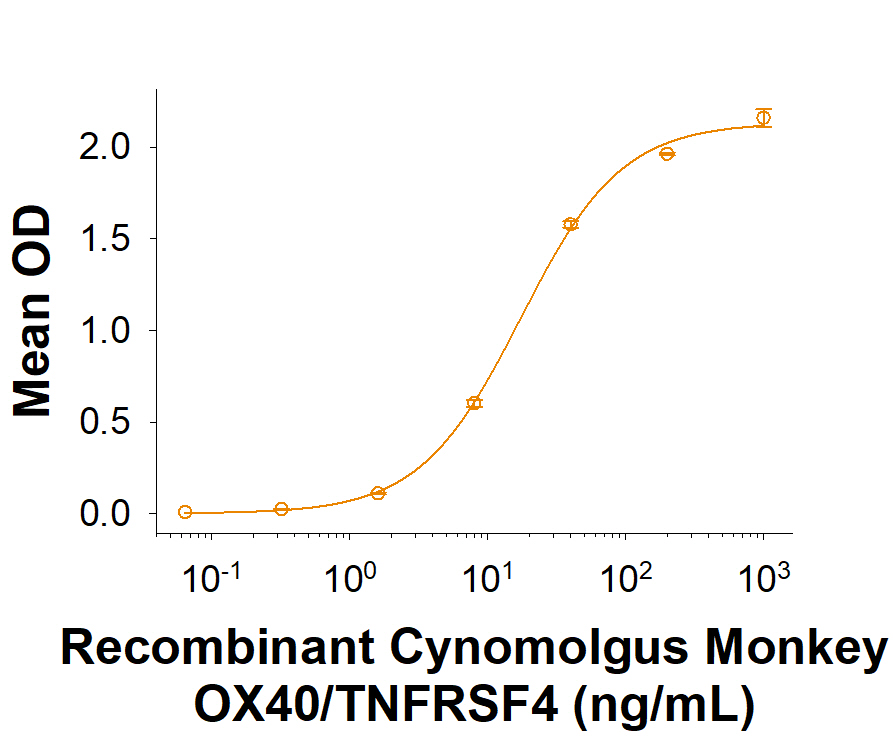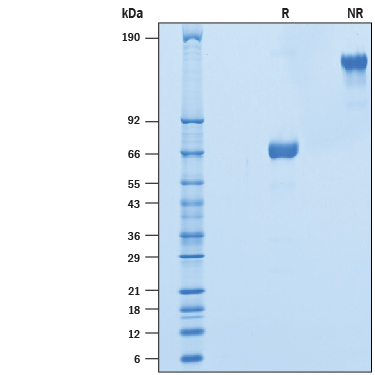Recombinant Cynomolgus OX40/TNFRSF4 Fc Chimera Protein, CF
Recombinant Cynomolgus OX40/TNFRSF4 Fc Chimera Protein, CF Summary
Product Specifications
| Cynomolgus Monkey OX40/TNFRSF4 (Leu29-Ala216) Accession # XP_005545179 | IEGRMD | Human IgG1 (Pro100-Lys330) |
| N-terminus | C-terminus | |
Analysis
Product Datasheets
Carrier Free
CF stands for Carrier Free (CF). We typically add Bovine Serum Albumin (BSA) as a carrier protein to our recombinant proteins. Adding a carrier protein enhances protein stability, increases shelf-life, and allows the recombinant protein to be stored at a more dilute concentration. The carrier free version does not contain BSA.
In general, we advise purchasing the recombinant protein with BSA for use in cell or tissue culture, or as an ELISA standard. In contrast, the carrier free protein is recommended for applications, in which the presence of BSA could interfere.
10311-OX
| Formulation | Lyophilized from a 0.2 μm filtered solution in PBS with trehalose. |
| Reconstitution | Reconstitute at 200 μg/mL in PBS. |
| Shipping | The product is shipped at ambient temperature. Upon receipt, store it immediately at the temperature recommended below. |
| Stability & Storage: | Use a manual defrost freezer and avoid repeated freeze-thaw cycles.
|
Scientific Data
 View Larger
View Larger
When Recombinant Human OX40 Ligand/TNFSF4 Protein (Catalog # 1054-OX) is immobilized at 250 ng/mL, the concentration of Recombinant Cynomolgus Monkey OX40/TNFRSF4 Fc Chimera (Catalog # 10311-OX) that produces the 50% optimal binding response is found to be approximately 5-30 ng/mL.
 View Larger
View Larger
2 μg/lane of Recombinant Cynomolgus Monkey OX40/TNFRSF4 Fc Chimera (Catalog # 10311-OX) was resolved with SDS-PAGE under reducing (R) and non-reducing (NR) conditions and visualized by Coomassie® Blue staining, showing bands at 62-72 kDa and 125-145 kDa, respectively.
Reconstitution Calculator
Background: OX40/TNFRSF4
OX40 (CD134; TNFRSF4) is a T cell co-stimulatory molecule of the TNF receptor superfamily that coordinates with other co-stimulators (CD28, CD40, CD30, CD27 and 4-1BB) to manage the activation of the immune response (1-3). Cynomolgous OX40 is a 47 kDa type I transmembrane glycoprotein with a 28 amino acid (aa) signal sequence, a 187 aa extracellular domain (ECD) that contains a cysteine-rich region, a 20 aa transmembrane segment, and a 41 aa cytoplasmic domain (4). The ECD of Cynomolgous OX40 shares 95%, 65% and 64% amino acid sequence identity with the ECD of human, mouse and rat OX40, respectively. OX40 is up‑regulated on CD4+ and CD8+ T cells upon engagement of the TCR by antigen presenting cells along with co-stimulation by CD40-CD40 Ligand and CD28-B7 (5, 6). OX40 Ligand is primarily expressed on antigen presenting cells (5). OX40 Ligand engagement of OX40 on activated CD4+ T cells results in increased T cell survival, proliferation, and cytokine production. It also inhibits the conversion of effector T cells into immunosuppressive regulatory T cells (T regs) and can promote the maintenance of and recall response in memory T cells (3, 7-10). OX40 is constitutively expressed on Tregs and enhances the sensitivity of T regs to IL-2, thus promoting Treg proliferation. OX40 has also been shown to decrease the cells' immunosuppressive activity on effector T cells (11-14). OX40-OX40 Ligand signaling is involved in allergic airway inflammation, graft-versus-host disease and autoimmune disease (6, 15, 16). Mutations in OX40 and OX40 Ligand are associated with cardiovascular disease (17, 18).
- Hori, T. (2006) Int. J. Hematol. 83:17.
- Latza, U. et al. (1994) Eur. J. Immunol. 24:677.
- Salek-Ardakani, S. et al. (2003) J. Exp. Med. 198:315.
- al-Shamkhani, A. et al. (1996) Eur. J. Immunol. 26:1695.
- Moran, A.E. et al. (2013) Curr. Opin. Immunol. 25:230.
- Gramaglia, I. et al. (1998) J. Immunol. 161:6510.
- Xiao, X. et al. (2008) J. Immunol. 181:3193.
- So, T. and M. Croft (2007) J. Immunol. 179:1427.
- Mousavi, S.F. et al. (2008) J. Immunol. 181:5990.
- Bansal-Pakala, P. et al. (2001) Nat. Med. 7:907.
- Piconese, S. et al. (2010) Eur. J. Immunol. 40:2902.
- Griseri, T. et al. (2010) J. Exp. Med. 207:699.
- Xiao, X. et al. (2012) J. Immunol. 188:892.
- Vu, M.D. et al. (2007) Blood 110:2501.
- Damayanti, T. et al. (2010) Am. J. Respir. Crit. Care Med. 181:688.
- Xiao, X. et al. (2012) Nat. Immunol. 13:981.
- Nakano, M. et al. (2010) Cardiovasc. Res. 88:539.
- Ishii, N. et al. (2010) Adv. Immunol. 105:63.
- Godfrey, W.R. et al. (1994) J. Exp. Med. 180:757.
FAQs
No product specific FAQs exist for this product, however you may
View all Proteins and Enzyme FAQsReviews for Recombinant Cynomolgus OX40/TNFRSF4 Fc Chimera Protein, CF
There are currently no reviews for this product. Be the first to review Recombinant Cynomolgus OX40/TNFRSF4 Fc Chimera Protein, CF and earn rewards!
Have you used Recombinant Cynomolgus OX40/TNFRSF4 Fc Chimera Protein, CF?
Submit a review and receive an Amazon gift card.
$25/€18/£15/$25CAN/¥75 Yuan/¥2500 Yen for a review with an image
$10/€7/£6/$10 CAD/¥70 Yuan/¥1110 Yen for a review without an image


